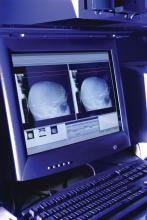Approximately one-third of children seen for head trauma visits in EDs underwent CT scans over a 9-year period in the United States, despite quality improvement initiatives to reduce unnecessary scans, based on a data from a cross-sectional survey published in Pediatrics.
“Computed tomography (CT) is the reference standard to provide a rapid and definitive diagnosis of intracranial pathology but must be balanced against the risks of radiation-induced malignancy,” wrote Brett Burstein, MD, PhD, of Harvard T.H. Chan School of Public Health, Cambridge, Mass., and his colleagues.
The researchers reviewed data from National Hospital Ambulatory Care Medical Survey database of nationally representative ED visits by children younger than 18 years for head trauma from 2007 to 2015. The median age of the patients was 6 years; 61% were boys. Approximately 88% were seen in nonteaching or nonpediatric hospitals.
During the 9-year period, 32% of 3,054 children underwent head CT scans; the 3,054 represented an estimated 14.3 million children making pediatric ED visits for head trauma. No significant differences were noted from year to year after the researchers controlled for confounding patient and ED factors.
Overall, use of CT was associated with patient’s age 2 years and older (adjusted odds ratio 1.51), white race (aOR 1.43), highest level of triage (aOR 8.24), and treatment at a nonteaching or nonpediatric hospital (aOR 1.47 and 1.53, respectively).
No significant differences in CT use were observed when the researchers compared the periods before (2007-2009) and after (2010-2015) the introduction of the Pediatric Emergency Care Applied Research Network (PECARN) rules – a clinical prediction protocol to assess head injuries in children in an ED setting. The unadjusted proportion of children who underwent CTs during the before PECARN and after PECARN periods was 33% and 31%, respectively.
“The finding of no decrease in CT neuroimaging during the 9-year study period, and particularly after the publication of the PECARN rules in 2009, was counter to the a priori hypothesis of this study,” Dr. Burstein and his associates noted.
The findings were limited by several factors including the lack of data on the severity of the head injuries, data on repeat visits, and potential misclassification of hospitals, they said. However, the results highlight the need for targeted interventions to disseminate the latest clinical decisions into practice.
Dr. Burstein and his associates had no financial conflicts to disclose.
SOURCE: Burstein B al. Pediatrics. 2018 Sept 4. doi: 10.1542/peds.2018-0814.

